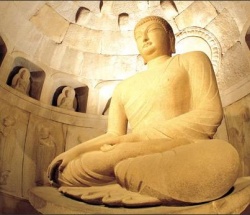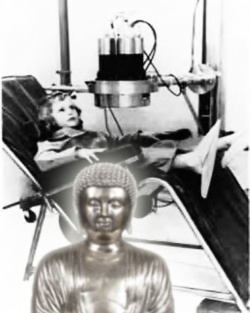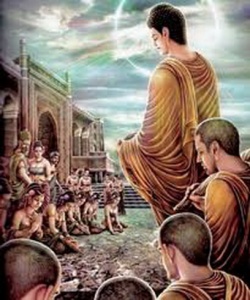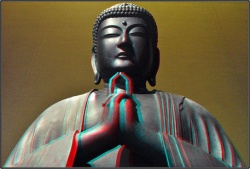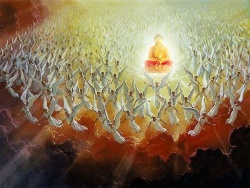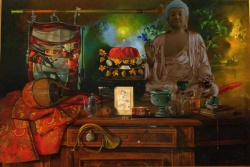Difference between revisions of "Hidden dimensions of astronomy"
m (Text replacement - "four quarters" to "four quarters") |
m (Text replacement - "particulars" to "particulars") |
||
| Line 11: | Line 11: | ||
The above was given out by the {{Wiki|adepts}} in the [[latter]] part of the nineteenth century. Much of it is now conceded by {{Wiki|astronomy}} as verified [[truth]], more is struggling to come to [[birth]]. The {{Wiki|adepts}} asserted their rejection of Gravity as then explained, stating their [[belief]] in the law of mutual magneto-electric [[attraction]] and [[repulsion]]. Today the Einsteinian [[cosmos]] with its curved spaces is an electro-magnetic ocean, and {{Wiki|matter}} has become "electricity held in magnetic bond." The {{Wiki|ancient}} and universally held [[belief]] that the [[worlds]] and systems filling [[space]] are a septenate, the [[belief]] which required not {{Wiki|hypothetical}} but very real layers of inner "ethereal" [[space]] to support the star-studded [[cosmic]] surface, still awaits the further personal energizings of men of [[science]] themselves. This will follow, according to [[Theosophy]], upon the discovery and [[recognition]], not only of the next "[[dimension]]" or the [[astral]] within [[physical]] [[space]], but equally of a complete set of inner within outer [[senses]], as being indispensable to [[evolution]]. | The above was given out by the {{Wiki|adepts}} in the [[latter]] part of the nineteenth century. Much of it is now conceded by {{Wiki|astronomy}} as verified [[truth]], more is struggling to come to [[birth]]. The {{Wiki|adepts}} asserted their rejection of Gravity as then explained, stating their [[belief]] in the law of mutual magneto-electric [[attraction]] and [[repulsion]]. Today the Einsteinian [[cosmos]] with its curved spaces is an electro-magnetic ocean, and {{Wiki|matter}} has become "electricity held in magnetic bond." The {{Wiki|ancient}} and universally held [[belief]] that the [[worlds]] and systems filling [[space]] are a septenate, the [[belief]] which required not {{Wiki|hypothetical}} but very real layers of inner "ethereal" [[space]] to support the star-studded [[cosmic]] surface, still awaits the further personal energizings of men of [[science]] themselves. This will follow, according to [[Theosophy]], upon the discovery and [[recognition]], not only of the next "[[dimension]]" or the [[astral]] within [[physical]] [[space]], but equally of a complete set of inner within outer [[senses]], as being indispensable to [[evolution]]. | ||
| − | [[Theosophy]] maintains that the [[myths]] and allegories -- if once correctly and thoroughly interpreted -- will dovetail with the most exact astronomical notions of our day. When one [[knows]] that the most exact {{Wiki|sciences}}, the greatest {{Wiki|mathematical}} and astronomical [[truths]], went forth among the hoi polloi under the guise of [[religious]] fables, from the circle of initiated {{Wiki|priests}}, the hierophants of the sanctum sanctorum, it may not be amiss to search for [[universal]] [[truths]] even under the patches of fiction's harlequinade. The fables about the {{Wiki|Pleiades}}, Atlas and {{Wiki|Hercules}} are found in the [[sacred]] [[Hindu]] [[books]], though under other names. An impenetrable [[veil]] of secrecy was thrown over the [[occult]] and [[religious]] {{Wiki|mysteries}} [[taught]], after the submersion of the last remnant of the Atlantean race, some 12,000 years ago, lest they should be shared by the unworthy and so desecrated. Of these {{Wiki|sciences}}, several have now become [[exoteric]], such as {{Wiki|astronomy}}, for instance, in its purely {{Wiki|mathematical}} and [[physical]] aspect. {{Wiki|Astronomy}} was once one of the [[sacred]] {{Wiki|sciences}} of those remote {{Wiki|Mystery}} Schools. Egyptian, {{Wiki|Babylonian}}, and above all [[Hindu]] astronomers, have left still extant remains and records, confirmed in many | + | [[Theosophy]] maintains that the [[myths]] and allegories -- if once correctly and thoroughly interpreted -- will dovetail with the most exact astronomical notions of our day. When one [[knows]] that the most exact {{Wiki|sciences}}, the greatest {{Wiki|mathematical}} and astronomical [[truths]], went forth among the hoi polloi under the guise of [[religious]] fables, from the circle of initiated {{Wiki|priests}}, the hierophants of the sanctum sanctorum, it may not be amiss to search for [[universal]] [[truths]] even under the patches of fiction's harlequinade. The fables about the {{Wiki|Pleiades}}, Atlas and {{Wiki|Hercules}} are found in the [[sacred]] [[Hindu]] [[books]], though under other names. An impenetrable [[veil]] of secrecy was thrown over the [[occult]] and [[religious]] {{Wiki|mysteries}} [[taught]], after the submersion of the last remnant of the Atlantean race, some 12,000 years ago, lest they should be shared by the unworthy and so desecrated. Of these {{Wiki|sciences}}, several have now become [[exoteric]], such as {{Wiki|astronomy}}, for instance, in its purely {{Wiki|mathematical}} and [[physical]] aspect. {{Wiki|Astronomy}} was once one of the [[sacred]] {{Wiki|sciences}} of those remote {{Wiki|Mystery}} Schools. Egyptian, {{Wiki|Babylonian}}, and above all [[Hindu]] astronomers, have left still extant remains and records, confirmed in many particulars by {{Wiki|modern}} research. In certain respects, however, these old observations deal with cycles so enormous as to be beyond the credence of our {{Wiki|present}} schools. |
The title given to the Initiate of the seventh [[degree]] of the {{Wiki|reception}} of the Mysteries was Astronomos. In days of old, {{Wiki|astronomy}} was {{Wiki|synonymous}} with [[astrology]], and the great [[astrological]] [[Initiation]] took place in {{Wiki|Egypt}}, where the {{Wiki|priests}} perfected, if they did not wholly invent, the [[science]]. In the Crata Nepoa, or the Mysteries of the {{Wiki|ancient}} Egyptian {{Wiki|priests}}, the following is described as the seven degrees of the [[initiation]]. After a preliminary trial at Thebes, where the neophyte had to pass through many trials, called the "Twelve Tortures," he was commanded to govern his [[passions]] and never lose for a moment the [[idea]] of his [[god]]. Then, as a [[symbol]] of the wanderings of the unpurified [[soul]], he had to ascend several ladders and wander in {{Wiki|darkness}} in a {{Wiki|cave}} with many doors, all of which were locked. When he had overcome the dreadful trials, he received the [[degree]] of Pastophoris, the second and third degrees being given other names. He was then conducted to the "hall of [[spirits]]," to be judged by them. Among the rules in which he was instructed, he was commanded "never to either [[desire]] or seek revenge; to be always ready to help a brother in [[danger]], even unto the [[risk]] of his own [[life]]; to [[respect]] [[old age]] and {{Wiki|protect}} those weaker than himself; and finally, to ever bear in [[mind]] the hour of [[death]], and that of {{Wiki|resurrection}} in a new and imperishable [[body]]." Then the neophyte was made a Kristophores. In this [[degree]], the fourth, the {{Wiki|mystery}} [[name]] IAO was communicated to him. In the following three degrees he was instructed in {{Wiki|chemistry}}, or [[alchemy]]; in the circle dance representing the course of the {{Wiki|planets}}, or {{Wiki|astronomy}}; and in the seventh he was initiated into the final Mysteries. Then after a final probation the Astronomos, as he was now called, emerged. ... and received a cross -- the Tau, which, at [[death]], had to be laid upon his {{Wiki|breast}}. He was now an hierophant, i.e., an {{Wiki|adept}} of the [[Sacred]] {{Wiki|Sciences}} and instructor in turn of them all. | The title given to the Initiate of the seventh [[degree]] of the {{Wiki|reception}} of the Mysteries was Astronomos. In days of old, {{Wiki|astronomy}} was {{Wiki|synonymous}} with [[astrology]], and the great [[astrological]] [[Initiation]] took place in {{Wiki|Egypt}}, where the {{Wiki|priests}} perfected, if they did not wholly invent, the [[science]]. In the Crata Nepoa, or the Mysteries of the {{Wiki|ancient}} Egyptian {{Wiki|priests}}, the following is described as the seven degrees of the [[initiation]]. After a preliminary trial at Thebes, where the neophyte had to pass through many trials, called the "Twelve Tortures," he was commanded to govern his [[passions]] and never lose for a moment the [[idea]] of his [[god]]. Then, as a [[symbol]] of the wanderings of the unpurified [[soul]], he had to ascend several ladders and wander in {{Wiki|darkness}} in a {{Wiki|cave}} with many doors, all of which were locked. When he had overcome the dreadful trials, he received the [[degree]] of Pastophoris, the second and third degrees being given other names. He was then conducted to the "hall of [[spirits]]," to be judged by them. Among the rules in which he was instructed, he was commanded "never to either [[desire]] or seek revenge; to be always ready to help a brother in [[danger]], even unto the [[risk]] of his own [[life]]; to [[respect]] [[old age]] and {{Wiki|protect}} those weaker than himself; and finally, to ever bear in [[mind]] the hour of [[death]], and that of {{Wiki|resurrection}} in a new and imperishable [[body]]." Then the neophyte was made a Kristophores. In this [[degree]], the fourth, the {{Wiki|mystery}} [[name]] IAO was communicated to him. In the following three degrees he was instructed in {{Wiki|chemistry}}, or [[alchemy]]; in the circle dance representing the course of the {{Wiki|planets}}, or {{Wiki|astronomy}}; and in the seventh he was initiated into the final Mysteries. Then after a final probation the Astronomos, as he was now called, emerged. ... and received a cross -- the Tau, which, at [[death]], had to be laid upon his {{Wiki|breast}}. He was now an hierophant, i.e., an {{Wiki|adept}} of the [[Sacred]] {{Wiki|Sciences}} and instructor in turn of them all. | ||
Latest revision as of 14:23, 30 December 2014
DID the ancients know of worlds beside their own? What are the data of the Occultists in affirming that every globe is a septenary chain of worlds -- of which only one member is visible? And that these globes are, were, or will be, man-bearing, just as every visible star or planet is? What do they mean by a moral and physical influence of the sidereal worlds on our globes?
Of all the branches of human knowledge, that which has yielded the most accurate information, afforded the most mathematically correct data, and of the achievements in which the men of science feel the most justly proud -- is astronomy. But if it has done much in the direction of satisfying man's straining and thirsting mind and his noble aspirations for knowledge, it has ever laughed at man's efforts to wrest the great secrets of Infinitude by the help of only mechanical apparatus. Thus, while the astronomer has achieved marvels in the elucidation of the visible relations of the orbs of space, he has learned nothing of their inner constitution. His science has led him no further towards a reading of that inner mystery than has that of the geologist, who can tell us only of the earth's superficial layers, and that of the physiologist, who until now has been able to deal only with man's outer shell. Nor, before developing his sixth sense, will the man of science concede the error of his theories in general.
The ordinary man has no experience of any state of consciousness other than that to which the physical senses link him. How, then, while these mysteries remain unexplored, can we hope to speculate with profit on the nature of globes which, in the economy of nature, must needs belong to states of consciousness other than and quite different from any which man experiences here? We have to proceed on analogy, to be sure. Yet the candid men of science are likely to find out that it is not sufficient to examine a few stars -- a handful of sand, as it were, from the margin of the shoreless, cosmic ocean -- to conclude that these stars are the same as all other stars, our earth included. No physical instrument will ever help astronomy to scan distances of the immensity of that of Sirius, 130 trillion miles away from the outer boundary of the spherical area.
The adepts know that almost all the planetary worlds are inhabited; and deny that there exist in the whole range of visible heavens any spaces devoid of starry worlds. There are stars, worlds and systems within as without the systems visible to man, and even within our own atmosphere. The turn of a four-dimensional world may be near, but the puzzle of science will ever continue until its concepts reach the natural dimensions of visible and invisible space in its septenary completeness. When demonstrated, the four-dimensional conception of space may lead to the invention of new instruments. Such predictions as these are possible for the adepts because they have learned how to penetrate to planes of consciousness quite different from those within the perceptions of ordinary men. Though an adept is unable to cross bodily the limits of the solar system, yet he knows that, stretching far beyond the power of telescopic detection, there are systems upon systems, the smallest of which would, when compared with the system of Sirius, for example, make the latter seem like an atom of dust imbedded in the great Shamo desert. The eye of the astronomer has never rested upon them, and yet these immeasurably distant worlds are brought as clear and near to the spiritual eye of the astral astronomer as a neighboring bed of daisies may be to the eye of the botanist.
The above was given out by the adepts in the latter part of the nineteenth century. Much of it is now conceded by astronomy as verified truth, more is struggling to come to birth. The adepts asserted their rejection of Gravity as then explained, stating their belief in the law of mutual magneto-electric attraction and repulsion. Today the Einsteinian cosmos with its curved spaces is an electro-magnetic ocean, and matter has become "electricity held in magnetic bond." The ancient and universally held belief that the worlds and systems filling space are a septenate, the belief which required not hypothetical but very real layers of inner "ethereal" space to support the star-studded cosmic surface, still awaits the further personal energizings of men of science themselves. This will follow, according to Theosophy, upon the discovery and recognition, not only of the next "dimension" or the astral within physical space, but equally of a complete set of inner within outer senses, as being indispensable to evolution.
Theosophy maintains that the myths and allegories -- if once correctly and thoroughly interpreted -- will dovetail with the most exact astronomical notions of our day. When one knows that the most exact sciences, the greatest mathematical and astronomical truths, went forth among the hoi polloi under the guise of religious fables, from the circle of initiated priests, the hierophants of the sanctum sanctorum, it may not be amiss to search for universal truths even under the patches of fiction's harlequinade. The fables about the Pleiades, Atlas and Hercules are found in the sacred Hindu books, though under other names. An impenetrable veil of secrecy was thrown over the occult and religious mysteries taught, after the submersion of the last remnant of the Atlantean race, some 12,000 years ago, lest they should be shared by the unworthy and so desecrated. Of these sciences, several have now become exoteric, such as astronomy, for instance, in its purely mathematical and physical aspect. Astronomy was once one of the sacred sciences of those remote Mystery Schools. Egyptian, Babylonian, and above all Hindu astronomers, have left still extant remains and records, confirmed in many particulars by modern research. In certain respects, however, these old observations deal with cycles so enormous as to be beyond the credence of our present schools.
The title given to the Initiate of the seventh degree of the reception of the Mysteries was Astronomos. In days of old, astronomy was synonymous with astrology, and the great astrological Initiation took place in Egypt, where the priests perfected, if they did not wholly invent, the science. In the Crata Nepoa, or the Mysteries of the ancient Egyptian priests, the following is described as the seven degrees of the initiation. After a preliminary trial at Thebes, where the neophyte had to pass through many trials, called the "Twelve Tortures," he was commanded to govern his passions and never lose for a moment the idea of his god. Then, as a symbol of the wanderings of the unpurified soul, he had to ascend several ladders and wander in darkness in a cave with many doors, all of which were locked. When he had overcome the dreadful trials, he received the degree of Pastophoris, the second and third degrees being given other names. He was then conducted to the "hall of spirits," to be judged by them. Among the rules in which he was instructed, he was commanded "never to either desire or seek revenge; to be always ready to help a brother in danger, even unto the risk of his own life; to respect old age and protect those weaker than himself; and finally, to ever bear in mind the hour of death, and that of resurrection in a new and imperishable body." Then the neophyte was made a Kristophores. In this degree, the fourth, the mystery name IAO was communicated to him. In the following three degrees he was instructed in chemistry, or alchemy; in the circle dance representing the course of the planets, or astronomy; and in the seventh he was initiated into the final Mysteries. Then after a final probation the Astronomos, as he was now called, emerged. ... and received a cross -- the Tau, which, at death, had to be laid upon his breast. He was now an hierophant, i.e., an adept of the Sacred Sciences and instructor in turn of them all.
The Mystery Schools in which the sciences were thus imparted were never the exclusive property of any one nation. The traditions coming exoterically from the four quarters are ever essentially without variation. Ouranos, the first teacher of astronomy, in India as in Greece, was called Tien in China. Thousands of years ago the Chinese divided their Zodiac into 24 parts, and their year into twenty-four fortnights; but which, according to The Secret Doctrine, did not prevent their having an astronomical year just the same as ours. They divided their year into two parts, from one equinox to the other. It is recorded of a Chinese Emperor of a relatively late epoch in Chinese history -- though more than 2000 years before the birth of Christ -- that he put to death his two chief astronomers for not predicting an eclipse of the sun. Schlegel assigned to the Chinese Astronomical Sphere an antiquity of 18,000 years.
There are modern researchers who think that the priest astronomers of the Mayas were "much better informed than the astronomers of any other civilized people of old. The tropical and sidereal year, the nodal motion of the moon, the symbolic and sidereal revolutions of the moon and planets were well known. Their astronomy was highly scientific, and as they had no astronomical instruments, their knowledge must have been handed down ... based upon traditions many thousands of years old."
Of the Sacred Sciences, India is the mother. Her adepts state that the Hindu calculations cover 850,000 years. They possess recorded observations from the date of the first great flood within the Aryan historical memory --that which submerged the last portion of greater Atlantis some 850,000 years ago.
In Astronomy of the Avesta (Pavri, 1925) is a description of Yazads who are there depicted as riding in chariots to which horses are yoked. The same idea, according to the author, is found in the Hindu stories of Rama and Ravana and the chariot Aruna which was supplied by Indra, the name of the chariot in the Avesta being Rath. The chariot in the story of Krishna and Arjuna was called Abhang. The author believes that the chariots of all these "gods" represent the outer bodies of the stars, and the Yazads, or "gods" who ride in the chariots are the inner principles of the heavenly bodies. The movements of some of the stellar bodies, he says, are described as the movements of the Yazads. "The description of this march or procession of stars gives us simple astronomical truths. Though scholars have hitherto refused to believe that the Iranians were proficient in astronomy, we will change our opinion when these passages describing the procession of the Yazads are properly interpreted."
The array of wise men who grace the classics of Greece is too long and illustrious to mention. Pythagoras had studied the esoteric sciences with the Brachmanes of India, and astronomy and astrology in Chaldea and Egypt. It was he who was first to teach the heliocentric system. Pythagoras is rated as the greatest geometer, mathematician and astronomer of antiquity, as also the highest of the metaphysicians and scholars. Neither Galileo nor modern astronomy discovered the emplacement of the planetary bodies. Thousands of years before, it was taught by the sages of Middle Asia, and brought to the west by Pythagoras, not as a speculation, but as a demonstrated science. The gravitation of science was known to the ancients and the medieval Hermetists as magnetism, attraction, affinity. It is a universal law, which is understood by Plato and explained in Timaeas as the attraction of lesser bodies to larger ones, and of similar bodies to similar, the latter following or exhibiting a magnetic power rather than following the law of gravitation.
Has the modern world really outgrown the Astrology of which mathematical astronomy is but the intellectual shell, according to those adepts who make public these old records? Has Astrology, the science of the inner principles of the heavenly orbs, been proved superstitious nonsense, whatever the antiquity assigned to it and its uncelebrated professors -- the adepts themselves? It is rather to be hoped that the learned and large body of astronomers will themselves become the first to investigate the truth of these claims, thereby dropping an outmoded custom of belittlement of those ancient savants.
